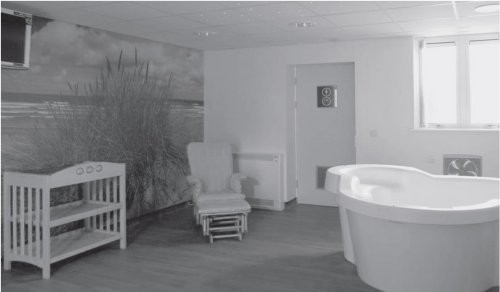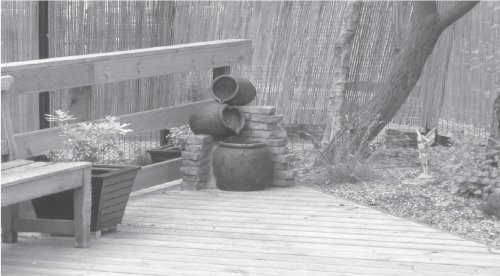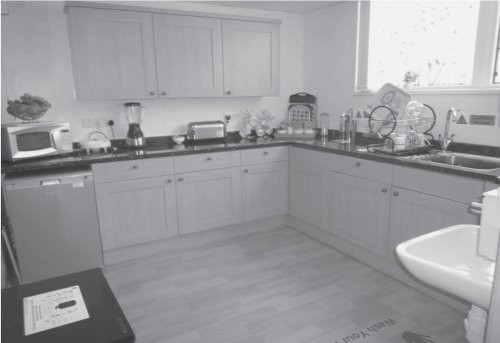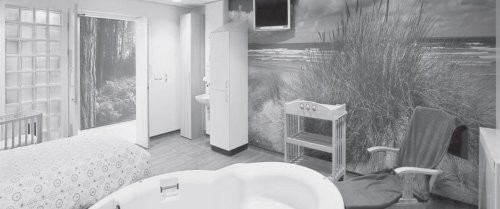AIMS Journal, 2011, Vol 23 No 1
Kathryn Gutteridge introduces a midwifery-led birth centre in Birmingham
In 2009, recruitment for midwives at Sandwell & West Birmingham Hospitals NHS Trust had exhausted all the normal creative ideas for tempting midwives to work with us. Maternity services at the Trust had experienced a long period of scrutiny from internal and external agencies which as always affects staff morale. During one of the meetings with the chief executive, he asked the question 'what would bring good-quality midwives to work with us?' The Head of Midwifery and myself simultaneously answered; 'A birth centre'; thus the new dawn of midwifery at our Trust was born.
From the agreement of our Trust board for the location and resources to develop the Serenity midwife-led birth centre (MLBC) and also funding for six whole-timeequivalent (wte) new posts plus six out of the current staffing, in less than 12 months the facility became operational. As most people working in the NHS will know this is nothing short of miraculous in terms of speed and agreement. However, when the chief executive gets behind a project anything is possible. The timing was spot on, the right people were in agreement and there was a real appetite for change within the service.
The brief was developed and was clear in both aims and outcomes; these are briefly outlined as;
A midwifery-led birth centre improves the training opportunities and experience of student midwives by offering exposure to a wider range of midwifery models of care and in turn assists in the retention of students once qualified.
Serenity MLBC is away from Delivery Suite and therefore named as a co-located birth centre. It has a drop-off area and its own entrance, which is clearly signposted. The doors are CCTV linked to within Serenity and entrance is controlled by the staff only.
When arriving onto Serenity it feels very different from any clinical area, with a calming atmosphere. There is a reception area which looks similar to a hotel reception. There are five rooms, all ensuite, with walk-in wet room facilities. Each room has its own characteristic and they are named Ruby, Sapphire, Jade, Amber and Violet.
Waterbirths are positively encouraged and each room has either a fixed or blow-up pool ready to go. No bed is seen in the room until after the bir th when the drop down double bed is lowered for both parents to rest with their new baby. All other birthing aids such as birth stool, Bradbury birth mats, glider chairs and birthing balls are available. All clinical equipment is housed inside the green storage and all natural wood finish furniture is for the woman and her family's storage or usage.
The shared kitchen is for staff and families alike and is much like a domestic kitchen. This leads out to a secured garden area for women and their families to use. A therapy room is located quietly away from the birthing rooms where women can receive treatments for a range of complementary therapies. The visitors can use a secluded rest room which has its own toilet facilities just for time out or if the woman wants some privacy.

It was important to develop a shared vision of the end facility as we had been allocated a vacated area that once had housed the neonatal unit; located away but down a corridor from Delivery Suite. The location is very important as many co-located birth centres fail due to their position within the service. The funding for the project was set at £850,000 and this was to include all building work, refurbishments and fittings.
A project group was set up and governance arrangements made; the actual work would be delivered by consultant midwife, project manager and other key stakeholders. Regular meetings were set and a programme of activity was agreed; the minutes of each meeting were scrutinised by the project board which included redesign director, divisional general manager, head of capital projects, head of midwifery, senior finance manager and service redesign manager. Set target dates were decided and timeframes agreed which is really important when developing a project otherwise it is easy to drift.
Some of the main pieces of work were decided and allocated; these were:
Once this plan was agreed and developed the work was quite frantic and began quickly.
Myself and the head of midwifery worked closely with the project manager and discussions were had about how this facility should look on completion. The project manager had never worked in maternity before but he was very innovative and excited by the challenges before him. I described a facility which would fit the name Serenity - the name had been suggested many months before by a father who was attending an aromatherapy session with his wife. I asked him what name he would call a future midwifery led service and so the name was born.
Paul the project manager visited other local birthing centres and had an idea of the model of care but I wanted to give our women something very different that would give them the 'WOW' factor. I asked Paul to consider how hospices were built around the family and patient needs and were often beautiful environments with great attention to nature. The vision and strap line for our project was: 'For one day in a woman's life - cared for with Serenity'.
The women who use maternity services at this Trust are in one of the poorest quintiles of Birmingham with factors such as,
Many of the women were unable to understand the concept of 'low-risk' and what a birth centre could offer them. It was important to try to share these ideas with women to capture their views. Some of the community midwives held group sessions with women where interpreters were present so time was taken to show the artist's impression and existing midwife-led services. The women and their families appeared to be both excited and curious about the proposals.
It was decided that we would offer an 'Opt Out' model of care which means that if women are assessed as low-risk throughout their pregnancy they would automatically come to Serenity unless they chose otherwise.
Meetings with midwives discussed current risk assessment of women, the way community midwives supported low-risk women's births at home and how the service could be improved. In general midwives were really open to change but for some there was an element of change fatigue. However, it was really vital to have all midwives aware of the new way of working.

To maintain the philosophy the midwifery team was fundamental to the success of the project. A team leader was appointed to manage the team in their daily activities and to support the midwives - support workers who would be integral to both women and their families. To ensure the calibre of midwives met our expectations a different approach was applied to the inter views. Midwives were invited for a whole day and everyone met each other over coffee.
This model of interviewing gave real insight into the interviewees' personal and midwifery belief systems and this was considered really important for this project.
Once the building work was nearing completion a date for opening was decided upon. Initially it was planned to be on Mothering Sunday 2010, giving a real purpose for the project. However due to recruitment completion we reviewed this and decided that we would have an official opening in April where we invited all involved in the project to attend and the centre was generously opened by Cathy Warwick General Secretary of Royal College of Midwives. Our reviewed operational opening date was set as 5th May 2010, International Day of the Midwife.
To ensure that we had offered women every opportunity to see what a birth centre looked like we had a two week period where we conducted open house tours. This was very successful and gave great feedback to the team. There was a period of two weeks prior to the operational date where all the staff began with an intensive two weeks of training and final stocks were received.

As with any first day we were all very nervous and keen that it should go without a hitch. The first labouring woman was diverted from Triage around to Serenity and she was shown into her room and the pool filled with water. However a few minutes later a second woman arrived in advanced labour ; she gave birth within 40 minutes of arrival and held her baby girl in her arms happy and pleased with everything. She later decided to call her baby Sakinah, which is Arabic for peaceful and serene; the local press loved the story and her parents were glad to give them their thoughts.
The Serenity Birth Centre has exceeded our expectations. It is a peaceful and serene place where low-risk women and their families can give birth without the trappings of a traditional delivery suite. Without exception, staff have embraced this project and feedback is positive and encouraging.
Some of the data so far has given a great boost to the model of care. Of over 800 women:
Data is collected in 'real time' which means a spreadsheet was set up and midwives put in data from each birth as soon after the event as possible; this automatically calculates the monthly activity. This makes midwives very aware of our key performance indicators and then makes it much easier to keep track of trends.
Comments from visitors to the Birth Centre have been very favourable. Some women are surprised to learn that the Birth Centre is provided as part of traditional NHS maternity services; one of the reasons is the high-quality finish and the innovative room designs, wall murals and ceiling star lights. Midwives are enjoying the experience of working in a woman-centred way in an environment that encourages the best from labouring women.

Finally
This has been a real gift to me as a midwife; very rarely in a career do the signs align to bring everything together in such an extraordinary way. There was such energy about the whole process and a great deal of pride in the finished product. Women and their families have been overwhelmingly positive about the care and environment, and it is a pleasure and an honour to have been involved and continue to be so much a part of this wonderful place.
With heartfelt thanks to; Elaine Newell Head of Midwifery, Paul Scott Project Manager, Mr Paul Bosio Clinical Director, Esther Rackley Inpatient Service, Sue Murray Divisional General Manager, Mr John Adler Chief Executive and Sarah Conlon Communications. No less thanks for Jill Beckett Team Leader and the rest of the Serenity Team but especially to all the women and their families for their encouragement and support.
The AIMS Journal spearheads discussions about change and development in the maternity services..
AIMS Journal articles on the website go back to 1960, offering an important historical record of maternity issues over the past 60 years. Please check the date of the article because the situation that it discusses may have changed since it was published. We are also very aware that the language used in many articles may not be the language that AIMS would use today.
To contact the editors, please email: journal@aims.org.uk
We make the AIMS Journal freely available so that as many people as possible can benefit from the articles. If you found this article interesting please consider supporting us by becoming an AIMS member or making a donation. We are a small charity that accepts no commercial sponsorship, in order to preserve our reputation for providing impartial, evidence-based information. You can make donations at Peoples Fundraising. To become an AIMS member or join our mailing list see Join AIMS
AIMS supports all maternity service users to navigate the system as it exists, and campaigns for a system which truly meets the needs of all.